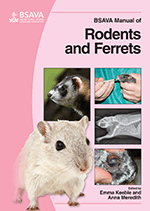
Full text loading...

Primary cardiac disease is a relatively common finding in pet ferrets, therefore it is important for practitioners to who work with this species to be able to recognize pertinent historical clues and physical examination findings as well as understand diagnostic and therapeutic options. Heart disease is most commonly diagnosed in middle-aged to older ferrets and presentations are similar to those seen in other species. In contrast, primary respiratory disease, with the exception of influenza, is uncommon in clinical practice and can affect ferrets of any age. A number of respiratory abnormalities are the result of primary cardiac disease, trauma, neoplasia, or space-occupying lesions. Even profound weakness (e.g. secondary to hypoglycaemia or systemic disease) can manifest as a respiratory abnormality. Cardiovascular and respiratory signs are intimately connected and the clinician should include diagnostic tests that will evaluate both systems in reaching a definitive diagnosis. This chapter considers Anatomy and physiology; General approach to the cardiorespiratory case; Cardiac disease; and Respiratory disease.
Ferrets: cardiovascular and respiratory system disorders, Page 1 of 1
< Previous page | Next page > /docserver/preview/fulltext/10.22233/9781905319565/9781905319565.26-1.gif

Full text loading...





